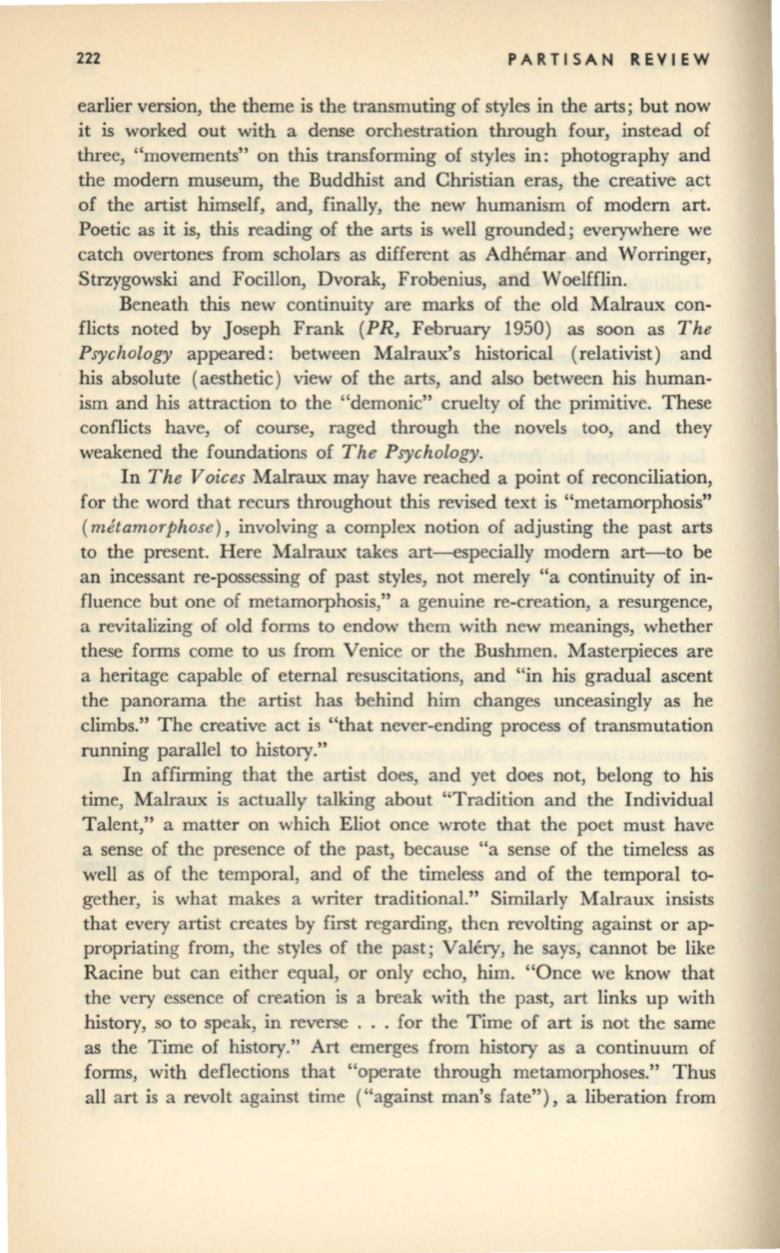
222
PARTISAN REVIEW
earlier version, the theme is the transmuting of styles in the arts; but now
it is worked out with a dense orchestration through four, instead of
three, "movements" on this transforming of styles
in:
photography and
the modern museum, the Buddhist and Christian eras, the creative act
of the artist himself, and, finally, the new humanism of modem art.
Poetic as it is, this reading of the arts is well grounded; everywhere we
catch overtones from scholars as different as Adhemar and Worringer,
Strzygowski and Focillon, Dvorak, Frobenius, and Woelfflin.
Beneath this new continuity are marks of the old Malraux con–
flicts noted by Joseph Frank
(PR,
February 1950) as soon as
The
Psychology
appeared: between Malraux's historical (relativist) and
his absolute (aesthetic) view of the arts, and also between his human–
ism and his attraction to the "demonic" cruelty of the primitive. These
conflicts have, of course, raged through the novels too, and they
weakened the foundations of
The Psychology.
In
The Voices
Malraux may have reached a point of reconciliation,
for the word that recurs throughout this revised text is "metamorphosis"
(metamorphose),
involving a complex notion of adjusting the past arts
to the present. Here Malraux takes art-especially modem art-to be
an incessant re-possessing of past styles, not merely "a continuity of in–
fluence but one of metamorphosis," a genuine re-creation, a resurgence,
a revitalizing of old forms to endow them with new meanings, whether
these forms come to us from Venice or the Bushmen. Masterpieces are
a heritage capable of eternal resuscitations, and "in his gradual ascent
the panorama the artist has behind him changes unceasingly as he
climbs." The creative act is "that never-ending process of transmutation
running parallel to history."
In affirming that the artist does, and yet does not, belong to his
time, Malraux is actually talking about "Tradition and the Individual
Talent," a matter on which Eliot once wrote that the poet must have
a sense of the presence of the past, because "a sense of the timeless as
well as of the temporal, and of the timeless and of the temporal to–
gether, is what makes a writer traditional." Similarly Malraux insists
that every artist creates by first regarding, then revolting against or ap–
propriating from, the styles of the past ; Valery, he says, cannot be like
Racine but can either equal, or only echo, him. "Once we know that
the very essence of creation is a break with the past, art links up with
history, so to speak, in reverse ... for the Time of art is not the same
as the Time of history." Art emerges from history as a continuum of
forms, with deflections that "operate through metamorphoses." Thus
all art is a revolt against time ("against man's fate"), a liberation from


